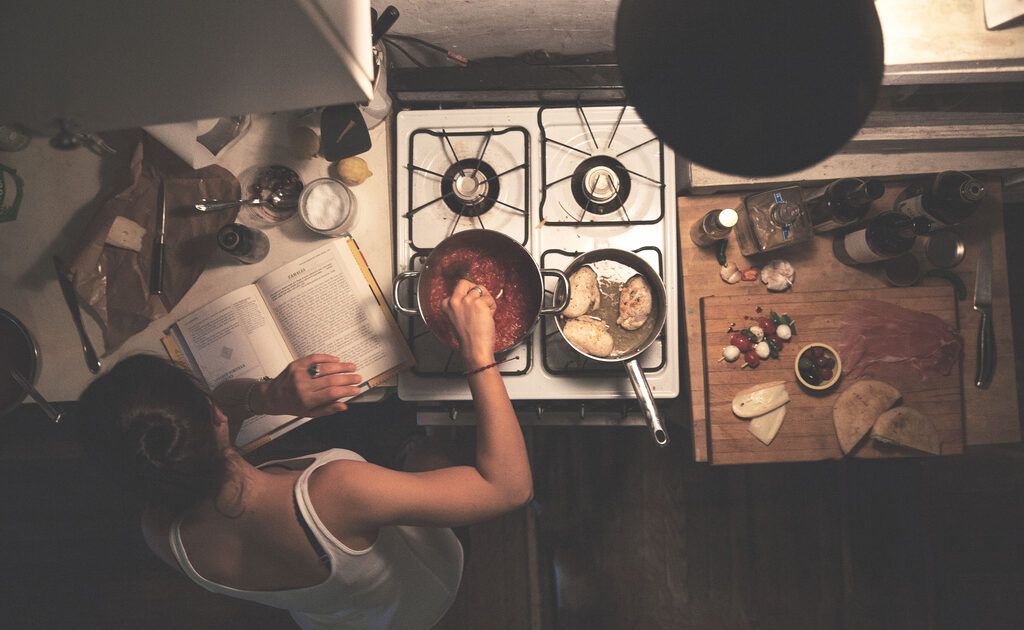27 Cooking Terms That’ll Make You Sound Like a Pro Chef (and Give You Great Recipe Ideas!)

In the kitchen, there are more ways to impress than with the walk – it’s with the talk! Becoming a chef is like learning an entirely new language, a lingo that goes beyond bon appetit. Cooking terms are great tools to use to not only impress guests but also develop a closer relationship with the art of cooking. Here are 27 random, but useful, cooking terms that will help you tighten your handle of chef’s jargon.
1. A blanc: French for “in white”, used to describe cream sauces that are prepared without being browned.
2. Affriander: French term referring to a stylish and appetizing presentation of a dish.
3. A point: French term pronounced “pwah” that describes food that is cooked just until done – no more, no less.
4. Bake blind: A technique in baking in which a pie or tart shell is cooked before being filled. This prevents a soggy crust or shell bottom. The shell is perforated with a fork to prevent air pockets and puffing, lined with aluminum foil, and weighed down with rice or beans.
5. Bard: To wrap fat, like bacon, around a lean cut of meat to keep it moist.
6. Baste: To continuously pour fat drippings or liquid atop baking or roasting meat, such as chicken, turkey, or beef to keep the cut moist.
7. Bouquet garni: A collection of herbs, such as parsley, thyme and bay leaves bound with twine and dropped in a soup, stock or sauce to add flavor. It is removed upon serving.
8. Chaud-froid: A French term referring to a dish that is cooked and then chilled before being served.
9. Chemisé: A French term for food that is wrapped, usually in puff pastry, or coated with a thick sauce.
10. Chiffonade: A French terms referring to a cut of thin strips, such as herbs and lettuce.
11. Crimp: To pinch together the edges of two pastries to seal in the filling.
12. Daube: A French term describing a method of braising meat in red wine stock that is seasoned with herbs.
13. Enophile: One who is an expert and lover of wines.
14. Flamber: A French term referring to pouring a flammable spirit over food and igniting it.
15. Hard-ball stage: This refers to a method for testing boiling sugar that has reached the point in which a drop of it immersed in cold water forms a hard or rigid ball that is slightly pliable. This usually occurs when the sugar temperature reaches 250-265 degrees Fahrenheit.
16. Hard-crack stage: This refers to a method for testing boiling sugar that has reached the point in which a drop it immersed in cold water separates into hard brittle threads. This occurs at 300-310 degrees Fahrenheit.
17. Maltaise: A French term describing foods prepared with a base of oranges, specifically blood oranges.
18. Monkey dish: A small, round bowl or saucer used in food service for side dishes or accompanying sauces.
19. Béchamel sauce: White cream sauce thickened with a roux.
20. Roux: A combination of flour and butter and used to thicken sauces or soups.
21. Veloute sauce: A stock (chicken, white veal or fish fumet) thickened with a roux. It can also be made thicker with egg yolk or cream.
22. Espagnole sauce: A brown sauce that is made from beef or veal stock, spices, herbs, and tomato.
23. Hollandaise sauce: An emulsion of fat and egg yolks. Mayonnaise is an example.
24. Pincer: A French terms referring to the browning of vegetables and bones in order to prepare stocks.
25. Score: To cut narrow gashes into fat to prevent the meat from curling when cooked. It can also refer too the cutting of even, shallow lines in vegetables as a form of decoration.
26. Smoke point: The point in which fat begins to smoke, giving off an unpleasant odor. For butter, this point is at 350 degrees Fahrenheit; for vegetable oil, it is at 450 degrees Fahrenheit; lard at 365-400 degrees Fahrenheit; and olive oil at 375 degrees Fahrenheit.
27. Venue: A French term used to describe the assembly and preparation of confections or pastry.
Related on Organic Authority
Harness Your Inner Chef: 6 Utensils Every Kitchen Should Have
5 Culinary Destinations Around the World You Shouldn’t Ignore
The 5 Best Culinary Herbs You’ve Never Heard Of
image: savetheworld

